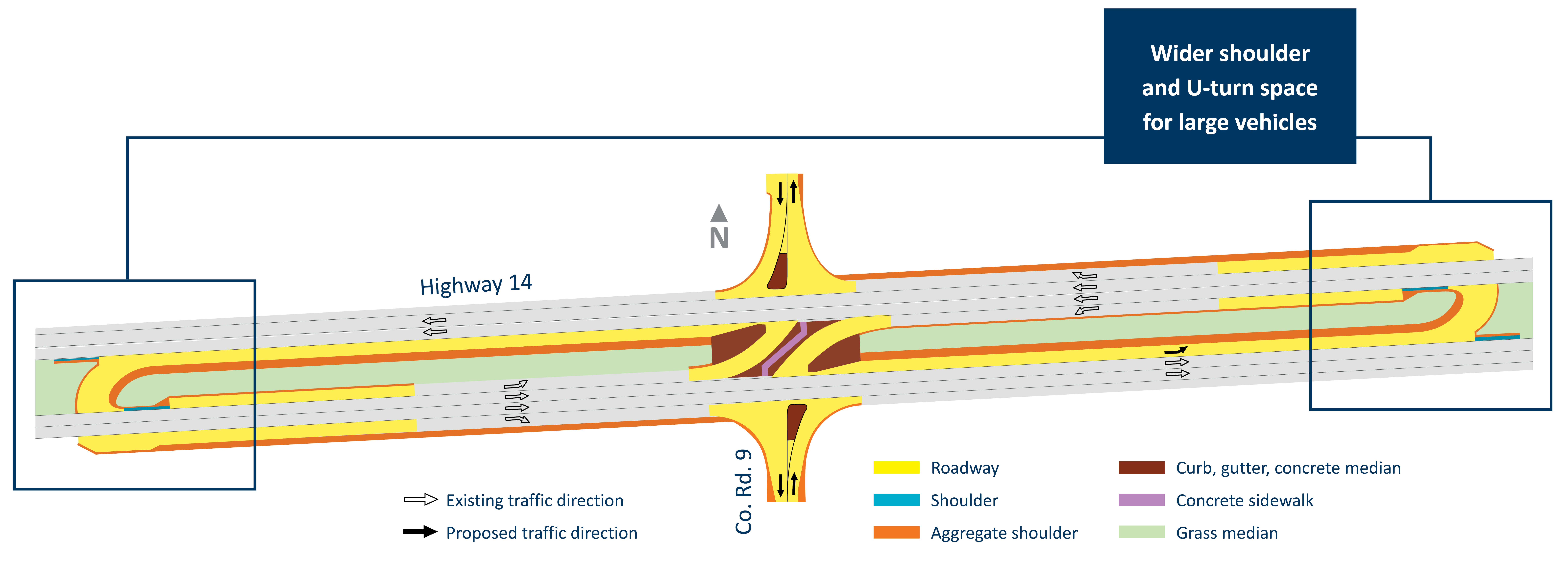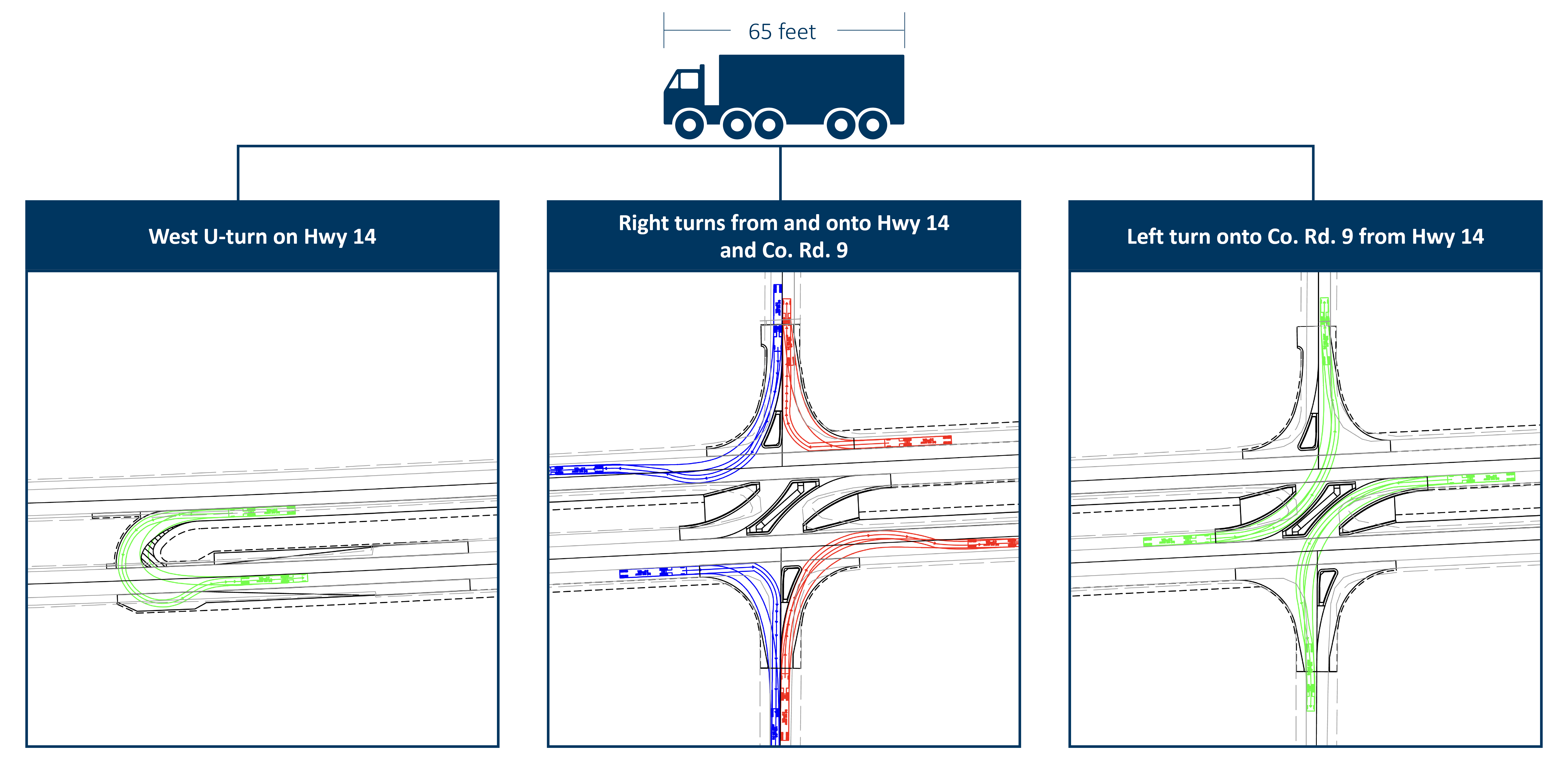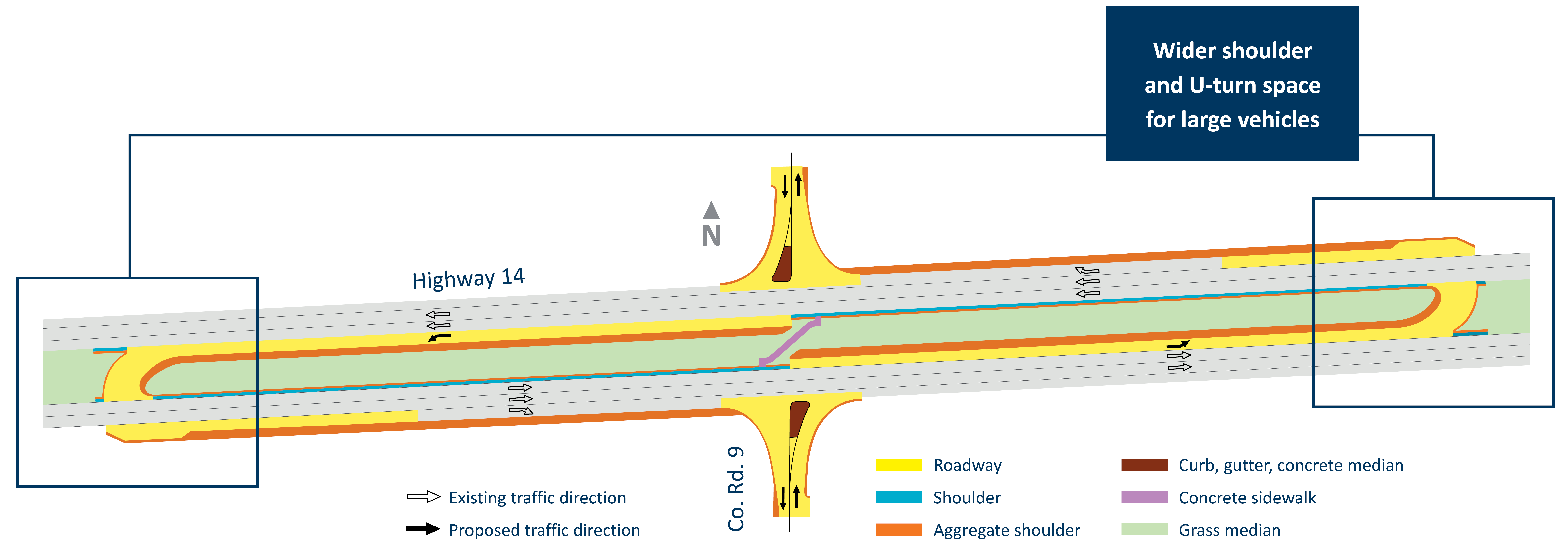Hwy 14 and Co. Rd. 9 — J-turn
Please go to the construction website to see the most up-to-date information about the schedule, detour details, etc. This website was used during the public engagement and design phase of the Hwy 14 project. That phase is complete, so now information about the project is on the construction website.
About the project
We will make improvements on Hwy 14 from east of Hwy 56 in Dodge Center to west of Co. Rd. 5 / 2nd Ave. in Byron. Construction will take place spring 2024 and end late summer 2024. The project includes the following improvements:
- Construct a J-turn (also known as a Reduced Conflict Intersection) at Hwy 14 and Co. Rd. 9
- Install a high-tension cable median barrier between Dodge Center and Kasson
- Resurface pavement between Kasson and Byron
- Improve and repair drainage
- Rehabilitate the eastbound and westbound Hwy 14 bridges over Hwy 57. The work includes new end posts, approach panels and expansion joints
- Upgrade the Road Weather Information System (RWIS) site near Byron with new pavement sensors and processing unit
The team looked at the three other intersections between Kasson and Byron. This project will not make changes at those intersections. We will take another look with a future project.
Hwy 14 and Co. Rd. 9 intersection
The Hwy 14 and Co. Rd. 9 intersection ha Current Hwy 14 and Co. Rd. 9 intersection, looking norths a high risk for severe crashes due to the multi-lane crossing and high traffic speeds. There have been 18 crashes in the past ten years. Three of these crashes involved injuries and one resulted in a fatality. The project team evaluated several options and collaborated with stakeholders and the community. The community also reviewed the options and provided feedback at several public meetings. The preferred option is to build a J-turn at the Hwy 14 and Co. Rd. 9 intersection.
Current Hwy 14 and Co. Rd. 9 intersection, looking norths a high risk for severe crashes due to the multi-lane crossing and high traffic speeds. There have been 18 crashes in the past ten years. Three of these crashes involved injuries and one resulted in a fatality. The project team evaluated several options and collaborated with stakeholders and the community. The community also reviewed the options and provided feedback at several public meetings. The preferred option is to build a J-turn at the Hwy 14 and Co. Rd. 9 intersection.
Learn more about J-turns and how they reduce risks for severe crashes.
Construction and Staging Information
You can find detailed information about construction, staging and detour routes in the information tab.
Be sure to sign up for project email updates. This list will be used to provide construction updates.
Please go to the construction website to see the most up-to-date information about the schedule, detour details, etc. This website was used during the public engagement and design phase of the Hwy 14 project. That phase is complete, so now information about the project is on the construction website.
About the project
We will make improvements on Hwy 14 from east of Hwy 56 in Dodge Center to west of Co. Rd. 5 / 2nd Ave. in Byron. Construction will take place spring 2024 and end late summer 2024. The project includes the following improvements:
- Construct a J-turn (also known as a Reduced Conflict Intersection) at Hwy 14 and Co. Rd. 9
- Install a high-tension cable median barrier between Dodge Center and Kasson
- Resurface pavement between Kasson and Byron
- Improve and repair drainage
- Rehabilitate the eastbound and westbound Hwy 14 bridges over Hwy 57. The work includes new end posts, approach panels and expansion joints
- Upgrade the Road Weather Information System (RWIS) site near Byron with new pavement sensors and processing unit
The team looked at the three other intersections between Kasson and Byron. This project will not make changes at those intersections. We will take another look with a future project.
Hwy 14 and Co. Rd. 9 intersection
The Hwy 14 and Co. Rd. 9 intersection ha Current Hwy 14 and Co. Rd. 9 intersection, looking norths a high risk for severe crashes due to the multi-lane crossing and high traffic speeds. There have been 18 crashes in the past ten years. Three of these crashes involved injuries and one resulted in a fatality. The project team evaluated several options and collaborated with stakeholders and the community. The community also reviewed the options and provided feedback at several public meetings. The preferred option is to build a J-turn at the Hwy 14 and Co. Rd. 9 intersection.
Current Hwy 14 and Co. Rd. 9 intersection, looking norths a high risk for severe crashes due to the multi-lane crossing and high traffic speeds. There have been 18 crashes in the past ten years. Three of these crashes involved injuries and one resulted in a fatality. The project team evaluated several options and collaborated with stakeholders and the community. The community also reviewed the options and provided feedback at several public meetings. The preferred option is to build a J-turn at the Hwy 14 and Co. Rd. 9 intersection.
Learn more about J-turns and how they reduce risks for severe crashes.
Construction and Staging Information
You can find detailed information about construction, staging and detour routes in the information tab.
Be sure to sign up for project email updates. This list will be used to provide construction updates.
-
Construction Staging
Share Construction Staging on Facebook Share Construction Staging on Twitter Share Construction Staging on Linkedin Email Construction Staging linkConstruction Stage 1
Construction will occur in two stages; inside lanes and outside lanes. The contractor will determine which stage will occur first. However, the bridge improvements at Hwy 57 will start with the inside lanes. Once construction begins, vehicles will not be able to cross or turn left onto Hwy 14 from Co. Rd. 9. One lane of traffic in each direction on Hwy 14 will be open throughout construction.
Stage one construction will include:
- Median U-turns and left turn lanes at Co. Rd. 9*
- High-tension cable median barrier installation*
- Bridge approach panels
- Overlay
*When these items are complete, stage 2 will begin, even if stage 1 bridge and overlay work is still being done. This will minimize the need for the Co. Rd. 9 detour.
Construction Stage 2
Construction will occur in two stages; inside lanes and outside lanes.
The contractor will determine which stage will occur first. However, the bridge improvements at Highway 57 will start with the inside lanes. Once construction begins, vehicles will not be able to cross or turn left onto Highway 14 from County Road 9. One lane of traffic in each direction on Highway 14 will be open throughout construction. When construction is complete, vehicles will be able to use the J-turn to access Highway 14 and County Road 9.
Stage two construction will include:
- Right turn lane extensions and “porkchops” at County Road 9
- Bridge approach panels
- Overlay
View full-sized image
View full-sized image
Detour Route
What to expect
Vehicles to the north of Hwy 14 will be detoured west on Co. Rd. 34 to southbound 200th Ave./Airport Dr. N to Hwy 14. Vehicles to the south of Hwy 14 will be detoured west on Co. Rd. 10 to Co. Rd. 25/Airport Dr. S to Hwy 14.
-
Public Meeting: July 20, 2023
Share Public Meeting: July 20, 2023 on Facebook Share Public Meeting: July 20, 2023 on Twitter Share Public Meeting: July 20, 2023 on Linkedin Email Public Meeting: July 20, 2023 linkWe presented these materials at a public meeting on July 20, 2023. People were asked to review and ask any questions.
If you were not able to attend, please review the materials and submit any questions and comments through the “Comments and Questions” section of this website. You can also contact Cindy Morgan at Cindy.Morgan@state.mn.us or 507-951-6593.
Crashes
In the past ten years, there have been 18 crashes at Co. Rd. 9
Among the 18 crashes:
- Three were north of Hwy 14 at the railroad crossing
- Three were run off the road, not specific to the intersection
Crossing or turning left across oncoming traffic is the number one risk at intersections like Hwy 14 and Co. Rd. 9. This type of crossing has more conflict points, which leads to more frequent and severe crashes.
J-turn Intersection
What is a J-turn?
A J-turn is an intersection type used to decrease risk of fatalities and injuries. With a J-turn, drivers from the side street only have to be concerned with one direction of traffic on the highway at a time. Drivers only need to wait for a gap in one direction at a time to cross.
What are the benefits?
Improved safety: Studies show an 86 percent reduction in fatalities and a 46 percent reduction in injury crashes where J-turns are used.
Faster to build: J-turns can be designed and built in approximately one year. Interchanges typically take 3-5 years.
Lower cost: J-turns are a fraction of the cost of building an overpass or interchange
How are they used?
Motorists approaching divided highways from a side street are not allowed to make left turns or cross traffic; instead, they will turn right onto the highway and then make a U-turn at a designated median opening. This reduces conflict points and increases safety.
Intersection Design
From Hwy 14: Motorists approaching from Hwy 14 are allowed to make left turns onto Co. Rd. 9.
From Co. Rd. 9: Motorists approaching Hwy 14 from Co. Rd. 9 are not allowed to make left turns at the intersection where they do today. Instead, motorists will turn right into a wide left turn lane and then make a U-turn at a designated median opening.
Features
- Fewer conflict points
- Increased safety
Construction Stage 1
Construction will occur in two stages; inside lanes and outside lanes. The contractor will determine which stage will occur first. However, the bridge improvements at Hwy 57 will start with the inside lanes. Once construction begins, vehicles will not be able to cross or turn left onto Hwy 14 from Co. Rd. 9. One lane of traffic in each direction on Hwy 14 will be open throughout construction.
Stage one construction will include:
- Median U-turns and left turn lanes at Co. Rd. 9*
- High-tension cable median barrier installation*
- Bridge approach panels
- Overlay
*When these items are complete, stage 2 will begin, even if stage 1 bridge and overlay work is still being done. This will minimize the need for the Co. Rd. 9 detour.
 View full-sized image
View full-sized image View full-sized image Construction Stage 2
View full-sized image Construction Stage 2Construction will occur in two stages; inside lanes and outside lanes.
The contractor will determine which stage will occur first. However, the bridge improvements at Highway 57 will start with the inside lanes. Once construction begins, vehicles will not be able to cross or turn left onto Highway 14 from County Road 9. One lane of traffic in each direction on Highway 14 will be open throughout construction. When construction is complete, vehicles will be able to use the J-turn to access Highway 14 and County Road 9.
Stage two construction will include:
- Right turn lane extensions and “porkchops” at County Road 9
- Bridge approach panels
- Overlay
Detour Route
What to expect
Vehicles to the north of Hwy 14 will be detoured west on Co. Rd. 34 to southbound 200th Ave./Airport Dr. N to Hwy 14. Vehicles to the south of Hwy 14 will be detoured west on Co. Rd. 10 to Co. Rd. 25/Airport Dr. S to Hwy 14.
-
Design Alternative 1 chosen for Hwy 14 and Co. Rd. 9 intersection
Share Design Alternative 1 chosen for Hwy 14 and Co. Rd. 9 intersection on Facebook Share Design Alternative 1 chosen for Hwy 14 and Co. Rd. 9 intersection on Twitter Share Design Alternative 1 chosen for Hwy 14 and Co. Rd. 9 intersection on Linkedin Email Design Alternative 1 chosen for Hwy 14 and Co. Rd. 9 intersection link We are moving forward with the design of Alternative 1 for the Hwy 14 and Co. Rd. 9 intersection.Two J-turn designs were evaluated. Alternative 1 allows drivers to turn left from Hwy 14 directly onto Co. Rd. 9. Alternative 2 requires drivers turning left off of the highway to use the median U-turn. We found that a majority of community members preferred Alternative 1 over Alternative 2.With Alternative 1, drivers approaching Hwy 14 from Co. Rd. 9 will not be able to turn left at the intersection where they do today. Instead, drivers will turn right into a wide left turn lane and then make a U-turn at a designated median opening. This means that drivers from Co. Rd. 9 will only have to look in one direction of traffic on Hwy 14 at a time.The design also features a wider shoulder and U-turn space. This will help large vehicles and agricultural equipment maneuver through the J-turn. Drivers will benefit by reduced travel time for vehicles crossing the highway. Separate left turn lanes will keep Hwy 14 traffic separate from traffic entering from Co. Rd. 9.
We are moving forward with the design of Alternative 1 for the Hwy 14 and Co. Rd. 9 intersection.Two J-turn designs were evaluated. Alternative 1 allows drivers to turn left from Hwy 14 directly onto Co. Rd. 9. Alternative 2 requires drivers turning left off of the highway to use the median U-turn. We found that a majority of community members preferred Alternative 1 over Alternative 2.With Alternative 1, drivers approaching Hwy 14 from Co. Rd. 9 will not be able to turn left at the intersection where they do today. Instead, drivers will turn right into a wide left turn lane and then make a U-turn at a designated median opening. This means that drivers from Co. Rd. 9 will only have to look in one direction of traffic on Hwy 14 at a time.The design also features a wider shoulder and U-turn space. This will help large vehicles and agricultural equipment maneuver through the J-turn. Drivers will benefit by reduced travel time for vehicles crossing the highway. Separate left turn lanes will keep Hwy 14 traffic separate from traffic entering from Co. Rd. 9.Hwy 14 and 260th Ave. intersection
After initial community feedback, we decided to not close the median at the Hwy 14 and 260th Ave. Future plans for the intersection will be discussed in future projects.
Future public meeting
A third public meeting will be held in 2023. The goal will be to let people know what they can expect from construction in 2024. We will also have information on how to navigate a J-turn.Thank you for your input over the last year. We began reaching out to the community in May 2022. This included in-person and virtual public meetings, online and paper surveys, newspaper and social media advertisements, as well as letters, postcards and emails to stakeholders. The feedback that we received has been incredibly helpful in determining the next steps of the project. -
How you can help
Share How you can help on Facebook Share How you can help on Twitter Share How you can help on Linkedin Email How you can help linkAs part of our design process, we gather information to help us make a choice about what changes to make. They have looked at the condition of the road surface, crash data, and more.Crash statistics show there is a safety risk at Hwy 14 and Co. Rd. 9. The crash data has also helped our engineers understand why those crashes happened. However, some information does not get reported. Things like near misses, or how the intersection services agricultural needs are examples.Feedback from the community will help us:- Understand issues and needs at the intersection
- Assess improvements or alternatives that meet the needs of all highway users
You can help by:
- Share your experiences or issues with Hwy 14 and Co. Rd. 9 intersection
- Attend a public meeting
- Sign up to receive project email updates
- Contact us with questions or comments
-
Public Meeting Materials, September 2022
Share Public Meeting Materials, September 2022 on Facebook Share Public Meeting Materials, September 2022 on Twitter Share Public Meeting Materials, September 2022 on Linkedin Email Public Meeting Materials, September 2022 link
We presented these materials at a public meeting on September 20, 2022. People were asked to review then and participate in a survey. The survey has since closed.
Crashes
In the past ten years, there have been 18 crashes at County Road 9
Among the 18 crashes:
- Three were north of Highway 14 at the railroad crossing
- Three were run off the road, not specific to the intersection
Crossing or turning left across oncoming traffic is the number one risk at intersections like Highway 14 and County Road 9. This type of crossing has more conflict points, which leads to more frequent and severe crashes.
Reduced conflict intersection
What is an RCI?
Reduced Conflict Intersections (RCIs) are intersections that decrease fatalities and injuries. With an RCI, drivers from the side street only have to be concerned with one direction of traffic on the highway at a time. You don't need to wait for a gap in both directions to cross a major road.
What are the benefits?
Improved safety: Studies show an 86 percent reduction in fatalities and a 46 percent reduction in injury crashes where RCIs are used.
Faster to build: RCIs can be designed and built in approximately one year. Interchanges typically take 3-5 years.
Lower cost: RCIs are often less expensive than constructing an intersection with a stop light and are a fraction of the cost of building an interchange.
How are they used?
Motorists approaching divided highways from a side street are not allowed to make left turns or cross; instead, they will turn right onto the highway and then make a U-turn at a designated median opening. This reduces potential conflict points and increases safety.
Design alternative 1
Features:
- Fewer potential conflict points
- Increased safety
From Highway 14: Motorists approaching from Highway 14 are allowed to make left turns onto County Road 9.
From County Road 9: Motorists approaching Highway 14 from County Road 9 are not allowed to turn left at the intersection where they do today. Instead, motorists will turn right into a wide left turn lane and then make a U-turn at a designated median opening.
Design alternative 1 turn movements
Design alternative 2
Features:
- Fewer potential conflict points
- Increased safety
From Highway 14: Motorists approaching from Highway 14 are not allowed to make left turns onto County Road 9. Instead, they are required to make a U-turn at a designated median opening.
From County Road 9: Motorists approaching Highway 14 from County Road 9 are not allowed to turn left at the intersection where they do today. Instead, motorists will turn right into a wide left turn lane and then make a U-turn at a designated median opening.
Design alternative 2 turn movements
Sight distance
Both design alternatives 1 and 2 allow for more than the required sight distance.
What is sight distance? Sight distance is the distance along the road a person can see an object that is a specified height above the road. As sight distance gets shorter, drivers become less certain that it is safe to pull out onto the road.
How much sight distance is needed? The rule of thumb we use is the distance an oncoming vehicle travels in 10 seconds. For a 70 MPH design, that distance is 1,029’. The drawings here show the sight distance for a passenger car (where the driver’s eye is 3.5’ above the ground) and a semi-truck (the driver’s eye is 7.6’ above the ground) and they want to see the windshield of an approaching car (3.5’ above ground).
Animation video
Animation video showing truck and agricultural vehicle movements through the RCI. NOTE: Vehicle speeds in the video have been proportionally reduced for viewing.
-
Virtual public meeting, June 28, 2022 (recording)
Share Virtual public meeting, June 28, 2022 (recording) on Facebook Share Virtual public meeting, June 28, 2022 (recording) on Twitter Share Virtual public meeting, June 28, 2022 (recording) on Linkedin Email Virtual public meeting, June 28, 2022 (recording) link
Sign up for email updates
Schedule
-
May-July 2022
Hwy 14 and Co. Rd. 9 — J-turn has finished this stageIdentify issues and needs of the community
-
August-September 2022
Hwy 14 and Co. Rd. 9 — J-turn has finished this stageDesign concepts and evaluate with the community
-
Winter 2022/23
Hwy 14 and Co. Rd. 9 — J-turn has finished this stageSelect the preferred option, share and educate the community
-
Winter-Fall 2023
Hwy 14 and Co. Rd. 9 — J-turn has finished this stagePrepare final documents for construction contract
-
Spring-Summer 2024
Hwy 14 and Co. Rd. 9 — J-turn is currently at this stageConstruction
Contacts
-

Email tom.austin@state.mn.us -

Phone 507-951-6593 Email cindy.morgan@state.mn.us


















